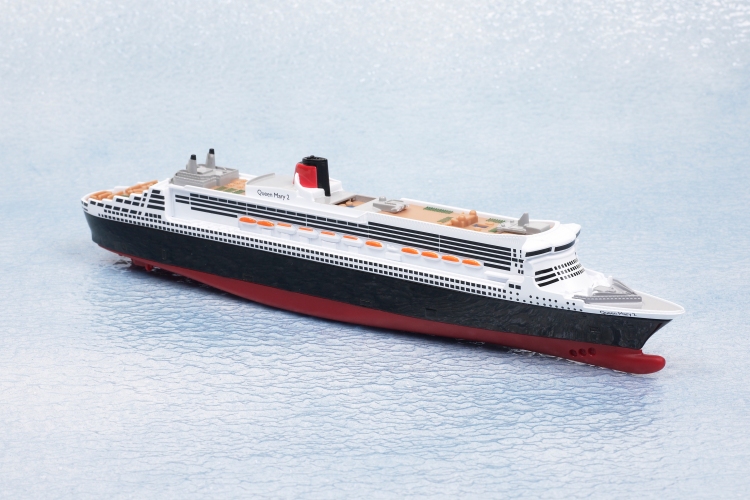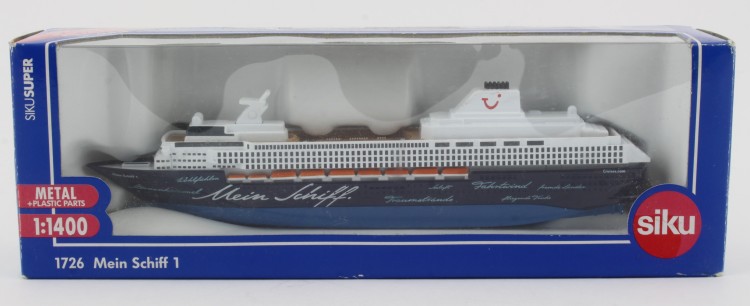Mike Pigott looks at the semi-waterline ship models in 1/1400 scale made by Siku of Germany.

In 2013, the long-established German company Siku introduced a range of cruise liners to its popular diecast line. These model ships were somewhat unorthodox, being of a semi-waterline design and made to the unusual scale of 1/1400, but were interesting replicas of modern liners not previously modelled.
Generally, toy and model ships (and this includes plastic, resin, white metal, and wood as well as diecast, plus construction kits and even souvenirs) are presented in one of two ways. They are either ‘waterline’ ships, which are flat-bottomed models without full hulls that represent the vessel as it appears when afloat. Sometimes these can include a base with concealed wheels, such as the Hornby Minic Ships, which gives them a bit more ‘play value’.
Alternatively, they can be ‘full hull’ models, representing the whole ship as it would appear out of water, such as when in dry-dock. These models are usually supplied with a stand. Some models can do both; ships made by Anguplas or French Dinky were waterline models that had clip-on plastic hulls, allowing them to be displayed in either fashion.
SIKU SHIPS
Siku is probably best known for its constant-scale 1/55 models of cars and trucks. Siku makes very good quality diecast toys, which are made to a much higher standard than Matchbox and Hot Wheels cars, but are also around twice the price. Some collectors have overlooked Siku models, because they fall somewhere between toys and models. They are better than the average diecast toy vehicles, but not quite up to the standard of fine-scale models. And that is probably intentional, as Siku has never really aimed at the collector’s market, and has always considered itself to be a producer of high-quality toys. Even the higher-priced 1/50 scale Siku Super Classic range seems to be aimed at kids, and tends to have plenty of moving parts and action features.
In addition to the standard cars, trucks and buses, the Siku Super line consists of various other types of vehicles, including trains, trams, aircraft, plus a wide range of tractors and agricultural vehicles in both 1/32 and 1/50 scales.
Recently some large cruise liners were introduced. These were produced in an unusual way. They were not waterline models like most toy ships, but had full hulls showing the rudders, propellers and bulbous bow. However, the underside was flattened, allowing the models to balance upright. They were also produced in an unusual scale. Instead of the traditional 1/1200 scale used for models ships (or 1/1250 as often favoured on the Continent), these were made to the rather oddball scale of 1/1400.
QUEEN MARY 2

One of the models was based on the new Cunard liner, Queen Mary 2. Launched in 2004, QM2 is the flagship of the Cunard fleet and is painted in the traditional colours of black and white with red trim. Although no longer the largest ship in the world, the QM2 is still the biggest ocean liner, as opposed to a cruise ship… she is the only vessel still doing the Southampton to New York Trans-Atlantic crossing. During the winter months, QM2 does luxury Caribbean cruises, and every year she does a round-world voyage visiting the Far East and Australia.

Siku’s model is a fairly accurate representation of Queen Mary 2, although very different in construction to other model ships. Unlike the Minic Ships, which were all-metal with only the funnels and masts in plastic, the QM2 is mostly plastic with just the black upper portion of the hull being diecast. The lower hull, the decks and the superstructure are all plastic, although there are different coloured components used. All of the windows and portholes are represented by black tampo printing; for the bridge area and the upper hull this is reasonably accurate, as these are large windows with dark, smoked glass. But the stripes along the upper decks are something of a short-cut, as these are meant to represent open balconies. The top decks are moulded in brown plastic to imitate the wooden decking, and the rows of sun-loungers have been touched in with green paint while the pools are painted blue. The lifeboats along the side have been coloured day-glow orange, with the funnel finished in red and black.
The join between the diecast black upper hull and the red plastic lower hull is completely level. When I bought the model, I expected to be able to remove the lower hull to convert it into a waterline ship. As Siku is first and foremost a toy company, my expectations were that the bottom could be removed to reveal a flat base, possibly with concealed wheels, so that kids could roll the model along the floor. However, the lower hull was firmly screwed in place, and would not separate even with the screws removed. I didn’t want to damage my model, but with a bit of effort it should be possible to convert the QM2 into a waterline model.
AIDA LUNA

Siku’s second model ship is a smaller and somewhat less famous ship than the Queen Mary 2. Aida Luna is one of the ten-strong fleet of Aida Cruises, a company not well known outside continental Europe. Aida Cruises runs German-speaking cruises aimed at the German and Austrian markets. The ships are based in Hamburg and mostly do short cruises around the Mediterranean, focusing on locations popular with Germans such as Mallorca and the Canary Islands. Aida aims its cruises at younger people, including families, and the ships even have a micro-brewery on board. But the most memorable feature of the Aida line is the eye-catching decorations on each ship; all of them have a stylized ‘face’, with a big red pair of lips on the bow and heavily made-up eye along each side.

The Siku Aida Luna is smaller than the QM2, but in some ways a better model. The hull is the only diecast part, as the decks and superstructure are again in plastic. The ship is all white with some blue trim, and the novelty face is very accurately reproduced. The windows and portholes are tampo printed in light grey and look reasonably convincing. The upper decks are represented by brown and dark blue plastic, and have the pools, sun beds, parasols and play areas touched in with blue and yellow paint. A glass atrium area in the top centre of the ship is not made of clear plastic, but still looks quite realistic.
Unlike the QM2, the Aida Luna does not have a level base. In fact, the bottom is much flatter and only the bulbous bow and the propellers can be seen. You have to wonder why it was made this way instead of simply being a waterline model.
MEIN SCHIFF 3

The Mein Schiff fleet is based in Hamburg and operated by TUI Cruises, part of the TUI AG conglomerate. Like Aida Cruises, TUI aims at the German-speaking market and runs a fleet of vessels that are all called Mein Schiff (My Ship). Mein Schiff 1 and 2 were second-hand liners bought from Celebrity Cruises, but Mein Schiff 3 is a brand new build, and considerably larger than its sister ships. These ships have white superstructures and unusual navy blue hulls. The name is written along the sides in white script, together with a number of German words that translate as ‘comfort’, ‘enjoyment’ and ‘sea air’, among others.

The Siku model follows the style of the other two, which features a diecast upper hull with the decks and lower hull in plastic. The superstructure is moulded in white, with the myriad windows printed in black. The top deck is in tan plastic, with a sporting field, pool and deckchairs all clearly represented. There is also a layer of translucent blue plastic, representing the front atrium, sunroofs, and the glass railing around the top decks, and this looks quite effective. The funnel is finished in white with a TUI logo. The hull is painted dark blue with accurate words printed in white script, and there are a number of lifeboats and lighters finished in fluorescent orange. Although this model has a level join between the upper and lower hulls, it is not possible to display it as a waterline model, as the base is attached by rivets.
MEIN SCHIFF 1

The most recent model is another Mein Schiff. As the name indicates, Mein Schiff 1 is the sister ship of Mein Schiff 3 – there is actually a fleet of six Mein Schiffs. Mein Schiff 1 was originally in the fleet of Celebrity Cruises, a subsidiary of Royal Caribbean, where it was known as MV Galaxy. In 2009 it was transferred over to start the TUI cruise line, being re-christened Mein Schiff, and later Mein Schiff 1 when other vessels were added to the fleet. These ships are regarded as being super-luxury cruisers. They have facilities that appeal to the German market, such as on-board breweries and traditional food, and itineraries to popular places like the Canary Islands and the Norwegian Fjords. In 2018, Mein Schiff 1 was transferred to TUI’s British subsidiary Marella Cruises (formerly Thompson Cruises) and re-named yet again as Marella Explorer.

Siku added this fourth ship model to its range in 2016. Like the previous items in the range, it is of a very odd design; being neither a waterline ship, nor a full-hull version. It has a flattened hull with bulbous bow and rear propellers visible. Only the upper part of the hull is diecast, with the flat lower hull and upper decks in plastic. The metal hull is painted navy blue, and covered by German words in script, as well as its name. The light blue words translate as ‘starry sky’, ‘dream beach’, ‘sea life’ and ‘midnight sun’. The upper decks are in white with the cabin windows tampo-printed in black. The top deck is brown plastic, representing wooden decking. There are three blue swimming pools and lots of white deck-chairs. The funnel area is white with a red TUI logo, and there is a separate command area with a white bridge, grey printed windows and two radar domes. In the middle decks are rows of lifeboats and pilots which are painted fluorescent orange.
PACKAGING

Being too large for the standard Siku blister packs, the four ships were packaged in their own unique window boxes with vac-formed inserts. Interestingly, there is a warning on the boxes that the ships DO NOT FLOAT!
This article was originally published in two parts in the January 2015 and April 2021 issues of Diecast Collector magazine.
Text and model photos (C) Mike Pigott 2021.

Interesting article Mike. I see that Siku also include a couple of 1:1000 scale ships in their range, with the same flattened yet full-hull treatment. They are quite nice models to look at if a bit bright, shame about the scale and lower hull.
LikeLike
They look very nice.
LikeLike